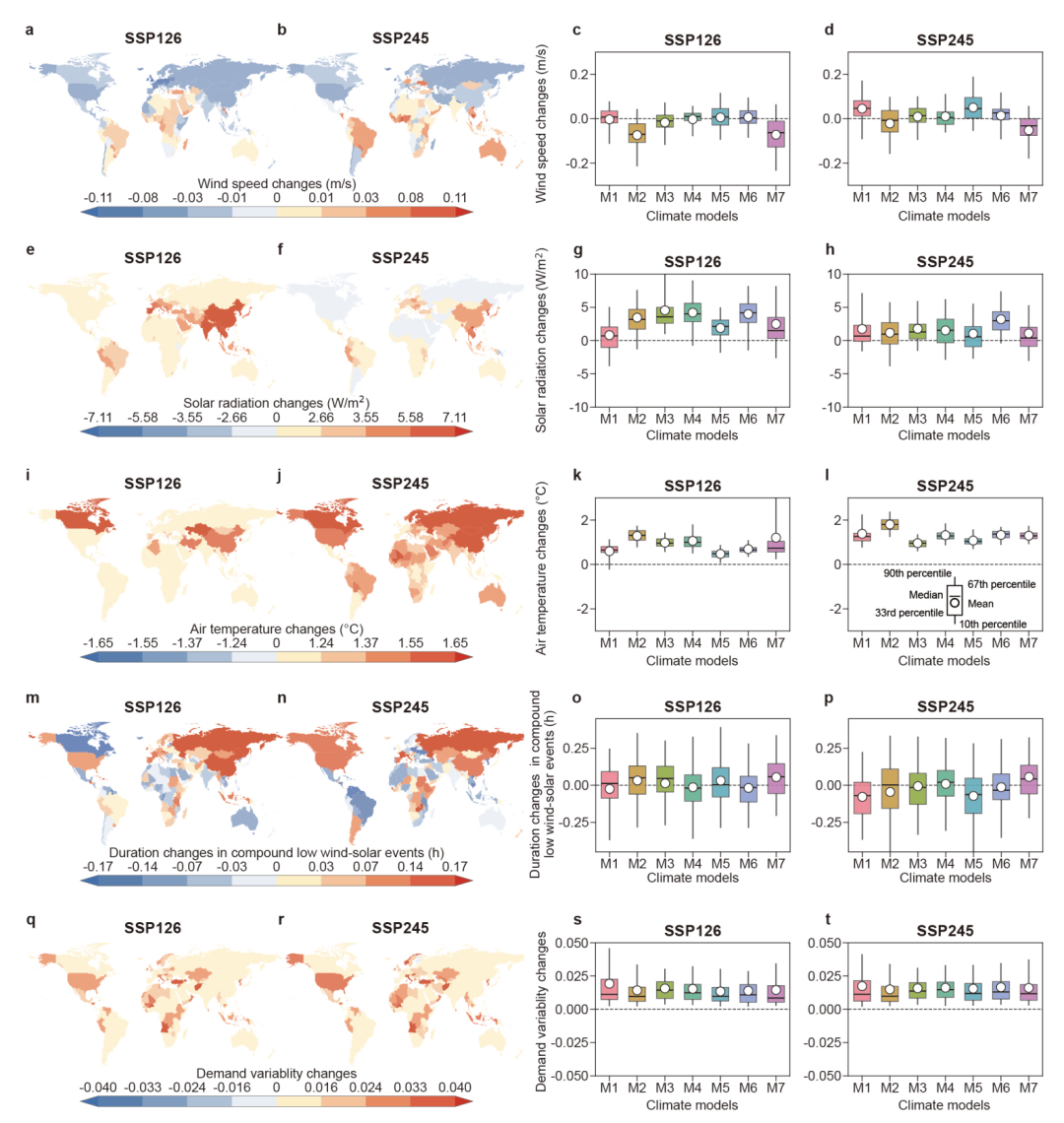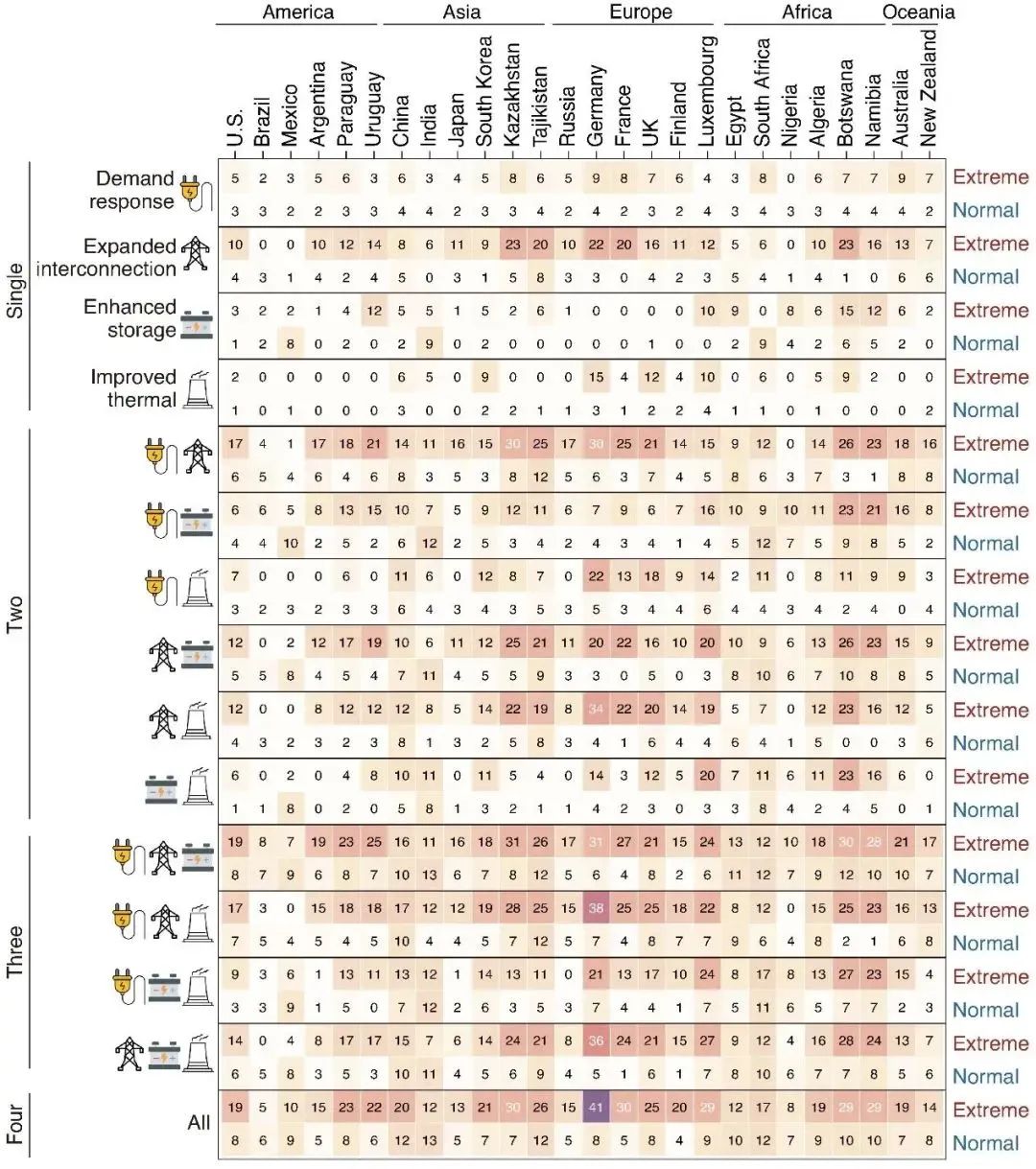Building a new power system dominated by renewable energy such as wind and solar power is a core technical pathway for promoting global clean energy transition and achieving the climate goals of the Paris Agreement. Climate change increases the frequency of extreme weather events, which affect wind and solar power supply and electricity demand, thereby exacerbating the risk of supply-demand imbalance in future high-penetration renewable power systems. To address short-term supply gaps under extreme weather conditions, additional thermal power capacity or energy storage systems are often required to ensure grid security, leading to increased system costs. Therefore, quantifying the climate risks of high-penetration wind-solar power systems, clarifying the cost-increasing mechanisms under extreme events, and developing adaptation strategies are of great scientific significance for establishing a secure, controllable, flexible, and efficient new power system.
To address this issue, research teams led by Professor Zhang Qiang and Associate Professor Tong Dan from the Institute for Carbon Neutrality and the Department of Earth System Science at Tsinghua University developed a coupled analysis framework integrating climate change, extreme events, and energy security. The study quantified the impact of future climate change on the reliability of global high-penetration wind-solar power systems, elucidated the scientific mechanisms through which prolonged low-wind-low-solar events cause supply-demand imbalances and cost increases, and proposed regionally differentiated climate adaptation and resilience enhancement strategies for global wind-solar power systems.
The research first quantified the impacts of future climate change (2056–2060 compared to 2016–2020) on wind and solar resources and electricity demand in 178 countries based on the CMIP6 multi-model multi-scenario dataset. Under the SSP1-2.6 scenario, while global surface temperature increases, the average global surface wind speed decreases by approximately 0.02 m/s, and average surface solar radiation increases by about 3.1 W/m². Changes in meteorological elements exhibit significant spatial heterogeneity, with more pronounced wind speed reductions in mid- and high-latitude regions and higher temperature increases compared to low-latitude regions (Figure 1). The study found that future changes in key meteorological elements will intensify supply-demand conflicts in high-penetration wind-solar power systems. Major countries will face longer durations of extremely low wind-solar output and increased load volatility, with particularly突出 risks in mid- and high-latitude countries experiencing greater wind speed reductions and temperature increases.

Figure 1. Future changes in key meteorological elements and their impacts on supply and demand in high-penetration wind-solar power systems
Using a power dispatch optimization model, the study simulated the hourly supply structure of various power generation technologies and analyzed cost trends during extreme periods via a cost decomposition algorithm. The additional costs and technological composition required to ensure supply-demand balance during extreme periods were calculated. Under the SSP1-2.6 scenario, the average cost per kWh during extreme periods (defined as the top 10% hours with the highest hourly electricity costs) increases significantly, with 47 countries experiencing cost increases exceeding 5%, and some even surpassing 20%. Although extreme periods account for only 10% of the total time, they contribute to 15%–30% of the total power system costs in major countries, highlighting the critical role of addressing supply-demand imbalances during these periods for enhancing system reliability. The study identified that increasing energy storage capacity is the primary driver of rising system costs.
Finally, the study designed 15 climate adaptation and resilience enhancement strategies for global wind-solar power systems based on four measures: demand-side response, interregional interconnection, improved energy storage efficiency, and enhanced flexibility of thermal power. The cost-reduction effectiveness of these strategies was quantified. While most single measures reduce system costs, combining multiple measures yields better results. For example, in India, the maximum cost reduction during extreme periods with any single measure is 6.3%, whereas combining two or three measures achieves maximum reductions of 10.8% or 12.3%, respectively (Figure 2). However, simply increasing the number of measures is not the optimal strategy; instead, tailored combinations based on national resource endowments are essential for maximizing cost-effectiveness.

Figure 2. Effectiveness of 15 climate adaptation and resilience enhancement strategies in reducing power system costs
The study reveals the impact mechanisms of future climate change on global high-penetration wind-solar power systems and proposes tailored, cost-effective strategies for enhancing climate resilience. The findings provide theoretical and scientific support for countries worldwide to build climate-resilient power systems on the path to net-zero emissions. Beyond exacerbating supply-demand imbalances, climate change also affects power system reliability and security through extreme events such as cold waves, typhoons, and heavy rainfall, increasing system costs. Future research could further refine the analytical framework to explore the potential impacts of various climate risk factors on high-penetration wind-solar power systems and develop corresponding strategies.
The related findings, titled "Strategies for climate-resilient global wind and solar power systems," were published online as an Accelerated Article Preview in Nature on June 18.
Dongsheng Zheng and Xizhe Yan, PhD students in the Department of Earth System Science at Tsinghua University, are co-first authors. Professor Zhang Qiang and Associate Professor Tong Dan are co-corresponding authors. Collaborators include Academician Deliang Chen, Professor and Xinghua Distinguished Chair at Tsinghua University; Academician Kebin He, Professor at the School of Environment and Director of the Institute for Carbon Neutrality at Tsinghua University; Professor Steven J. Davis from Stanford University; Professor Ken Caldeira from the Carnegie Institution for Science; postdoctoral researchers Yaqin Guo and Jingyun Li from Tsinghua University; postdoctoral researcher Yang Liu from the School of Environment; postdoctoral researcher Jing Cheng from Stanford University; PhD students Peng Wang and Shijie Feng, research assistant Yuanyuan Lin, and visiting PhD student Liying Ping from the Department of Earth System Science. The research was supported by the National Natural Science Foundation of China International (Regional) Cooperation and Exchange Program, the Carbon Neutrality and Energy System Transformation (CNEST) Program, and the New Cornerstone Science Foundation Science Exploration Award.
Paper Link:
https://www.nature.com/articles/s41586-025-09266-7
 Latest recommendations
Latest recommendations


